Chettiar is a title used by many traders, weaving, agricultural and land-owning castes in South India, especially in the Indian states of Tamil Nadu, Kerala and Karnataka.

Chettinad is a name that collectively refers to a locality that comprises 56 villages in the Sivaganga district and 20 villages in Pudukottai district, which was historically ruled by the Ramnad kingdom of Pandya Nadu. It has a small portion extending into the Pudukottai District in Tamil Nadu; Karaikudi is the major town of this area and is considered the urban center for the Chettinadu villages.
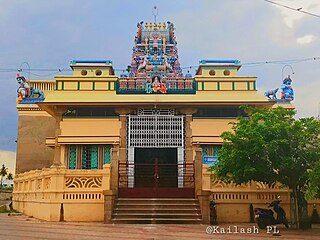
Devakottai is a first-grade municipality in the state of Tamil Nadu, India. Located in the Sivaganga district, the town is situated close to the Karaikudi, near Rameswaram National Highway Road (NH-210). It is one of the major cities comes under the Chettinad area with rich heritage of houses built with limestone called "Karai Veedu". This Region is one of the towns in Chettinad belt. The town is famous for its ancient temple Sri Meenakshi Sundareswarar temple also known as Nagara Sivan Kovil.

Sir Alagappa Chettiar was an Indian businessman and philanthropist. He received the Padma Bhushan, the third highest civilian award of India in 1956.

Chettinadu cuisine (Setti Nadu in tamil) is the cuisine of a community called the Nattukotai Chettiars, or Nagarathars, from the Chettinad region in Sivaganga district of Tamil Nadu state in India. Chettinad cuisine is perhaps the most renowned fare in the Tamil Nadu repertoire. It uses a variety of spices and the dishes are made with fresh ground masalas. Chettiars also use a variety of sun-dried meats and salted vegetables, reflecting the dry environment of the region. Most of the dishes are eaten with rice and rice based accompaniments such as dosas, appams, idiyappams, adais and idlis. The Chettiars, through their mercantile contacts with Burma, learnt to prepare a type of rice pudding made with sticky red rice. The chefs of manapatti village near Singampunari are experts in cooking Chettinad cuisine. They always used to cook in bulk orders for marriage functions, political functions, etc. though manapatti cooking is portrayed as madurai cuisine because it is located near to madurai district, it comes under chettinad cuisine only and it also comes under the chettinad region of sivagangai district. The entire village people is famous in the art of cooking.
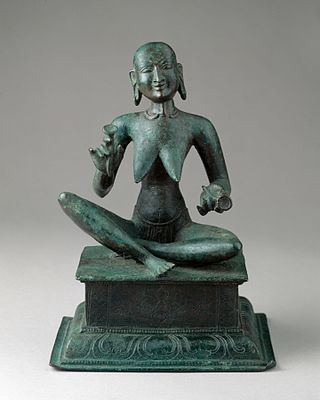
Karaikal Ammaiyar, meaning "The Revered Mother of Karaikal", is one of the three women amongst the 63 Nayanmars and one of the greatest figures of early Tamil literature. She was born in Karaikal, South India, and probably lived during the 5th century AD. She was a devotee of Shiva.

Sivaganga District is one of the 38 districts in Tamil Nadu state, India. This district was formed on 15 March 1985 by trifurcation of Ramanathapuram district into Ramanathapuram, Virudhunagar and Sivaganga districts. Sivaganga is the district headquarters, while Karaikudi is the most populous city in the district, administered by the Karaikudi Municipal Corporation. It is bounded by Pudukkottai district on the Northeast, Tiruchirappalli district on the North, Ramanathapuram district on South East, Virudhunagar district on South West and Madurai district on the West. The area's other larger towns include Sivaganga, Kalayar Kovil, Devakottai, Manamadurai, Ilaiyangudi, Thiruppuvanam, Singampunari and Tiruppattur. As of 2011, the district had a population of 1,339,101 with a sex ratio of 1,003 females for every 1,000 males.

Tamilakam was the geographical region inhabited by the ancient Tamil people, covering the southernmost region of the Indian subcontinent. Tamilakam covered today's Tamil Nadu, Kerala, Puducherry, Lakshadweep and southern parts of Andhra Pradesh and Karnataka. Traditional accounts and the Tolkāppiyam referred to these territories as a single cultural area, where Tamil was the natural language and permeated the culture of all its inhabitants. The ancient Tamil country was divided into kingdoms. The best known among them were the Cheras, Cholas, Pandyans and Pallavas. During the Sangam period, Tamil culture began to spread outside Tamilakam. Ancient Tamil settlements were also established in Sri Lanka and the Maldives (Giravarus), prior to the migration of Prakrit speakers.

Diwan Bahadur Sir Satappa Ramanatha Muthiah Annamalai Chettiar, Raja of ChettinadKCSI better known as Raja Sir Annamalai Chettiar was an Indian industrialist, banker, educationist and philanthropist from Tamil Nadu. He was the founder of Annamalai University in Chidambaram and one of the founders of Indian Bank, along with his brother S. Rm. M. Ramaswami Chettiar.

Karpaka Vinayaka Temple or Pillaiyarpatti Pillaiyar Temple is a 7th-century-CE rock-cut cave shrine, significantly expanded over the later centuries. It is located in Pillayarpatti village in Tiruppathur Taluk, Sivaganga district in Tamil Nadu, India.

Sengunthar, also known as the Kaikolar and Senguntha Mudaliar is a caste commonly found in the Indian state of Tamil Nadu, Andhra Pradesh and the neighboring country Sri Lanka. In Andhra Pradesh, they are known as Kaikala or Karikala Bhaktulu, who consider the early Chola emperor Karikala Chola as their hero. They were warriors of Cholas and traditionally textile merchants and silk weavers by occupation They were part of the Chola army as Kaikola regiment and were dominant during the rule of Imperial Cholas, holding commander and minister positions in the court. Ottakoothar, 12th century court poet and rajaguru of Cholas under Vikrama Chola, Kulothunga Chola II, Raja Raja Chola II reign belong to this community. In the olden days in India, the Sengunthars were warriors and were given the title Mudaliar for their bravery. In early thirteenth century, after the fall of Chola empire large number of Kaikolars migrated to Kongu Nadu from Tondaimandalam and started doing weaving and textile businesses as their full time profession as they sworn to be soldiers only for Chola emperors. At present, most of the textile businesses in Tamil Nadu are owned by Senguntha Mudaliars. Majority of Sengunthars are sub-divided into numerous clans based on a patrilineal lineage known as Koottam or Gotra.
Ainnurruvar is a medieval merchant guild originating in the Karnataka region of India between the 8th and 13th centuries. In this period, organised merchant guilds exerted considerable power and influence. Ainnurruvar was one of the most prominent of these guilds. During the Chola Empire they were regarded as the elite amongst the South Indian merchant organizations.
Nachandupatti is a small town located 16 kilometres from Pudukkottai in the Pudukkottai district of the Indian state of Tamil Nadu. Many members of the Nagarathar groups are among its inhabitants. The town contains historic temples. Various festivals and religious ceremonies take place here. There are many small villages around Nachandupatti including Pudur and Kottur.
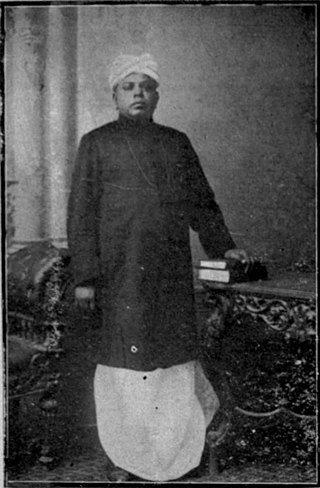
Diwan Bahadur Satappa Ramanatha Muthiah Ramaswami Chettiar was an Indian businessman from what is now the state of Tamil Nadu.
Muthiah Annamalai Muthiah RamaswamyChettiar better known as Rajah M.A.M.Ramasamy Chettiar an Indian industrialist, politician and race horse owner who served as Chairman of the Chettinad Group of Companies and a member of the Upper House of the Parliament of India, the Rajya Sabha for Karnataka representing the Janata Dal (Secular) from 2004 to 2010.

Sir Muthiah Annamalai Muthiah Chettiar, Rajah of Chettinad KCSI better known as RajahSir Muthiah Chettiar was an Indian Industrialist, banker, politician, philanthropist, and cultural activist who served as First Mayor of Madras city (1933) and Minister of Excise and Education (1936–37) in the provincial government of Madras Presidency.
The S. Rm. family is an Indian family of businessmen, industrialists and bankers from the town of Kanadukathan in the Sivaganga district of Tamil Nadu, India. The family is named after its ancestor, the popular 19th-century Nagarathar banker S. Rm. Muthiah Chettiar. The head of the family holds the honorific title Raja of Chettinad. The M. Ct. family has descended from one branch of the S. Rm. family.
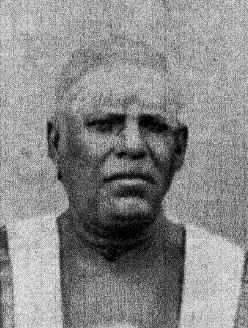
Sathappa Ramanatha Muthiah Chettiar (1840-1900) was an Indian merchant, banker and philanthropist known for his work in renovating Saivite temples in India. He was the patriarch of the S. Rm. M. family.
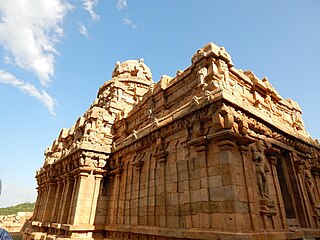
Vijayalaya Choleeswaram in Narthamalai, a panchayat town in Pudukottai district in the South Indian state of Tamil Nadu, India, is a temple dedicated to the Hindu god Shiva, Vishnu and houses the 8th century Jaina Abode. The temple is considered one of the oldest stone temples in South India. The other portions of Narthamalai houses the 8th century Jaina Abode, the Aluruttimalai Jain Caves. The Temple is Constructed in the Dravida style and rock cut architecture, the temple is believed to have been built during the 9th century by Mutharaiyar dynasty kings, the cardinals of Pallavas, with later expansion from the Cholas. The rock-cut architecture is an early example of Cholan Art, continuing the tradition of the Pallavas.
The Chettinad mansions are a collection of over 10,000 lavish homes of the Nattukottai Chettiar community in the region of Chettinad in South India. These mansions were built with materials from all across the globe to signify the community's wealth as merchants in the late 19th and early 20th centuries. The mansions blended global features with traditional Tamil architecture to form homes for large joint families. Since World War II, conservation efforts have been ongoing to maintain these homes and draw in tourists from across the globe. However, preserving the mansions has been difficult due to legal challenges and cost barriers. The Chettiar community has looked to upkeep their built heritage by leasing the houses to Indian hotel chains and exploring other solutions.















